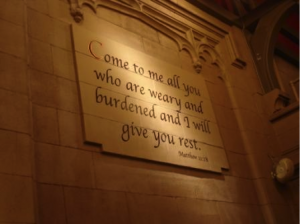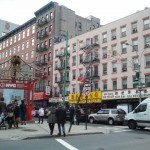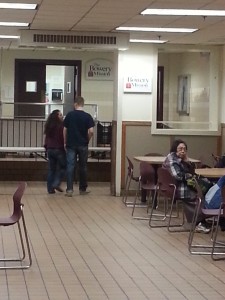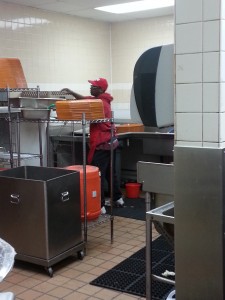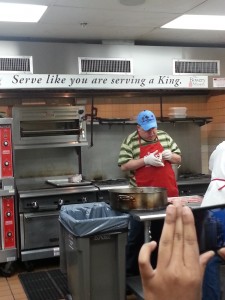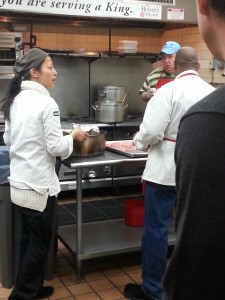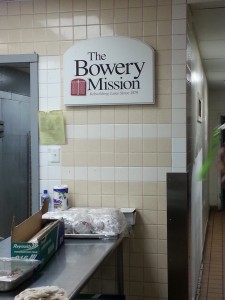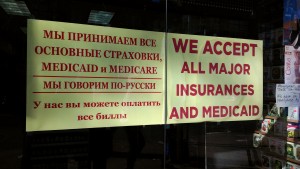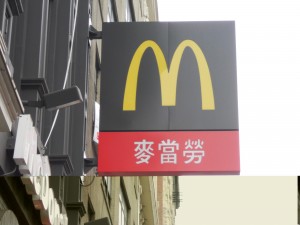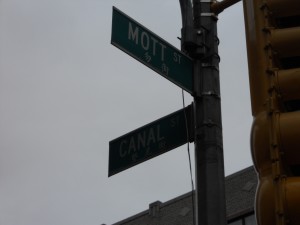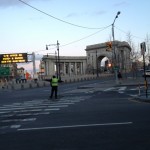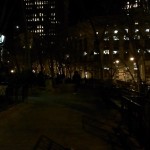Here are a few more videos that I took:
Category Archives: Neighborhood Posts
Homecrest-Ave U Field Notes (04/06/13) Part 2
On April 6th, Kate Zarudna and I went to the Homecrest, Ave U Chinatown again. This time, heading from Coney Island Ave goes until E. 15th street (where the Ave U, Q-line train station is located).
So, immediately, we saw that there were quite a few hair salons relatively close together within, basically, one block of each other. There were Chinese-owned hair salons, Russian-speaking hair salons on the same street (about 12th to 14th Streets, I think). There were about five hair salons. Actually, three or four of them were Chinese (or Asian) owned and there was only one salon that was owned by Russian-speaking people (one can never be sure exactly from which ex-Soviet republic). The two types of salons appeared to have separate clientele; however one or two of the Asian salons were completely empty while the only Russian-speaking owned salon was packed with middle-aged women.
Besides the hair salons, there are obviously many businesses along the street that appear to be prospering. Among them are: tech-based businesses, nail salons, and general stores (99¢ stores), and many, many, pharmacies. In the fresh food stores and the various clothing stores (rather inexpensive clothing, not the boutiques), all nationalities were represented: Russian, Chinese, Hispanic.
Besides the two predominant groups that have businesses and eateries along Ave U, here were also a couple restaurants that served Vietnamese cuisine and there were also two Mexican restaurants. We are not sure about their clientele, but most likely all ethnicities frequent those restaurants. One a slightly different note, we went to a Japanese restaurant on Ave u (Tokyo Sushi) and all the customers (at the time when we were eating at least) were Russian-speaking, while the employees were only Chinese.
Since this was our second visit, we also went in to a different Chinese-owned traditional herb medicine store that caters to both Russian and Chinese clients.
Bowery Mission Images: Ashley Haynes, Shanin Chowdhury, Anissa Daimally

The diversity amongst the cooks at the Bowery Mission which also describes the population of people they service. The quote in the background, “Serve like you are serving a King,” speaks to how the Bowery Mission treats all of the people they service despite their socioeconomic standing.
-Ashley Haynes
Bowery Mission Field notes: Anissa Daimally, Shanin Chowdhury, and Ashley Haynes
During spring break, my group and I visited the Bowery Mission. It was a drop off location during Hurricane Sandy, so we figured we would be able to gather a sufficient amount of information for our project. At the Bowery Mission, we interviewed Matt Krivich, the operations director. Matt was very helpful and insightful compared to the people at the Charles B. Wang Center who were very unreceptive to trying to aid in our project. In the interview, Matt Krivich informed us that the mission lost power for five days like so many others as a result of Hurricane Sandy. However, knowing that the mission still had the duty to provide service and food for the people in the neighborhood, Matt divulged how the mission managed without having electricity. They cooked all of their perishables. Through generator power, they were able to preserve what wasn’t cook. During and following the storm there was an influx of volunteers. Compared to the usual thirty volunteers, there were over a hundred. Matt also told the story about an Asian family who was initially very hesitant about coming into the Bowery. However, after being welcomed in, Matt spoke about how more Asian families started to come to the mission through word of mouth.
-Ashley Haynes
Chinatown Interview 2-Wendy Li, Lisa Torre, Linda Wong
Chinatown Interview 2:
Columbus Park Musician Interview: http://youtu.be/tLwn–j_PJw
The man we interviewed regularly goes to Columbus Park. However he lives in government housing further uptown on 27th Street. During the storm, the only difficulty he faced was carrying water up to his floor, 8th floor. Other than that, he did not feel affected and used his cellphone during the power outage. The government gave about a hundred dollars worth of aid for the storm but he said it did not really help much. However, it didn’t matter because he had few relatives in the city and only lived with his wife and they didn’t have large expenses to cover. He also made a comment on how government housing is much better now and living in government housing is helpful since it is based on income, and he had low income.
- Various Chinese stores on Mulberry Street.
- Souvenir shops
- Inside of a souvenir shop
- Tourist shops on Canal Street
- Centre Street and Canal Street
- The Chinatown information booth and fish markets
- People gather around in Columbus Park to play cards and chess
- This is a common sight of musicians gathering in Columbus Park.
Chinatown Interview 3 – Wendy Li, Linda Wong, Lisa Torre
This is an interview with two jewelry store owners in Chinatown. They spoke to us about their experiences with Hurricane Sandy. They said they could not open the store because there was no electricity, and they needed lights to display the jewelry. There was no one in the streets, and it was really dark like a “dead city.” You would only know people were near you if you bumped into them. Their business was negatively affected, like after 9/11, when as a result of the disaster there is now little to no business. The government offered them loans which they would have to pay back, but they did not see these as necessary since they did not lose any of their jewelry like a food store owner would lose his perishables. They have an apartment in Chinatown and one in Queens, so they were able to stay in their unaffected Queens home.
Bowery Mission-Anissa Daimally, Shanin Chowdhury, and Ashley Haynes
Field Notes
The Bowery Mission
Over the spring break, we visited the Bowery Mission and inquired their role in Hurricane Sandy. The Bowery Mission, located on 227 Bowery Street, is an organization that is part of the nonprofit Christian Herald Association. Its purpose is to provide to “provide help and hope to the homeless and impoverished in New York.” We were able to speak to Matt Krivich, the previous Director of Operations and now Assistant Director at the Bowery Mission. He informed us that during Hurricane Sandy, they lost electricity for about five days. Due to loss of power, they were forced to cook perishables until they received generators to store the rest of the food. There was no major infrastructural damage; only a couple of windows were broken. During and after Hurricane Sandy, the organization saw new residents from the Lower East Side and from Chinatown coming for assistance, in addition to their normal guests. These residents came mostly for the meals provided. Krivich mentioned that a Chinese family stood outside of the center, wondering if they were able to come in. The organization was kindhearted and invited the family into the building. After this family received this assistance, word of mouth spread and more families from Chinatown came to the organization for help. Overall, the Bowery Mission proved to be effective during Hurricane Sandy; they had all the resources and experience needed to provide disaster relief.
Reference: http://www.bowery.org/about-us/purpose-goal/
NYC Chinatown Description
Chinatown, Manhattan is home to approximately 100,000 Chinese immigrants. In fact, it currently holds the largest group of Chinese immigrants in the entire nation. With this in mind, it is no surprise that this neighborhood is a cultural hub with manifest hallmark centers, stores, and ample sites to see and explore.
Chinatown is located in the lower side of Manhattan. The neighborhood accommodates various sorts of Chinese luxuries, the most alluring of which include restaurants, arts and crafts stores, to more specific traditional amenities such as vendors of Chinese herbs, clothing, and jewelry. When my group and I were strolling through Chinatown near Canal Street, we came across a street vendor selling Chinese Sweet Mini Cakes, with the price of fifteen for a dollar. This, however, is just one of the many unique features and social centers that are vested on the streets of New York City’s Chinatown.
In addition to remarkable Chinese dining center and restaurants, Chinatown also contains cuisines from many different parts of Asia as well, including, but not limited to Malay, Thai, and Japanese.
Even still, fine dining is not Chinatown’s only specialty. The neighborhood is imbued with landmarks, monuments, and historical sites that easily manifest the rich history of the community and make it apparent to anyone taking a casual saunter through the neighborhood. These benchmark sites include The Church of the Transfiguration, the Edward Mooney House, and the Mahayana Buddhist Temple.
All these remarkable features of Chinatown, perceptibly diffused with patent Chinese culture at every crevice of the neighborhood, combine to make it a social hub full of life, culture, and civilization beyond generations of time.
– Nadera Rahman
Photos From Homecrest/ Avenue U
Homecrest/Ave U (03/09/2013) Field Notes
On March 9th 2013, I went to Avenue U in Homecrest, Brooklyn with Kate Zarudna. We covered what I thought to be the scope of the chinatown there, basically from 15th street to 25th street. Now, it is highly likely that there was a significant Asian population if we walked from the Avenue U station (on the Q line) in the descending order of streets, it just so happened that we decided to walk east. We had visited several establishments and businesses in the area, and asked the workers if Sandy had affected them in any way. We had tried to do this as least intrusively as possible, but nevertheless the majority of the Asian residents did not show any desire to talk to us. Upon us mentioning the word “questions” many of the people we talked to appeared to grow suspicious and mistrusting of us, which was completely understandable. Furthermore, I would like to point out that there was a noticeable language barrier with the older generations of Asian locals (as can be expected).
In Acupuncture and Herb Remedy store, there were Russian advertisements; however, there appeared to be no Russian-speaking workers on premises at the time and the owner was Chinese. He did not appear to understand our questions related to Sandy (or maybe simply did not want to answer.)
At Dr.Wireless, a general tech store, the sales attendant answered that no damage from Sandy occurred, and that we should check further down, closer to Sheepshead Bay. Business continued as usual.
We also stopped at a Russian-owned pharmacy on Avenue U. We felt more comfortable interviewing one of the ladies working there in Russian, and to be honest this method yielded better results. Of course, as to the state of Avenue U after Sandy, the answers were much the same, Ave U was not harmed and business continued much as usual despite the natural disaster. According to the lady, there are also many Russian-speaking people in the area along with the Chinese. It was she who specified the damage was more on Ave Y and headed us in that direction.
As we walked south to Avenue Y, the area becomes instantly residential. Damage from Sandy is no longer evident in the area either because it was cleaned up already or because there wasn’t much.
On Avenue Y and Ocean Ave there was an “International Food” Store (a very probable sign that it was Russian-owned). We asked the cashier about Sandy and finally got evidence of Sandy’s impact; apparently their basement was flooded but they did not lose power. Essentially their business closed down only for a couple days for repairs.
Chinatown Interview – Wendy Li, Linda Wong, Lisa Torre
Interview of a Chinatown resident about his experience during Hurricane Sandy:
Homecrest-Avenue U (03/09/2013)
Here are some videos I took while on Ave U with Kate Zarudna.
Manhattan Chinatown – Research Action Plan
Our group has chosen to focus on the work of local community organizations in Manhattan during the crisis of Superstorm Sandy. The government left this ethnic enclave in the dark at this time, thus facilitating the need for local organizations to step in and help the residents of Manhattan Chinatown.
We will focus our study on the work of the CAAAV, a grassroots community organization whose goal is to empower diverse Asian immigrants. The CAAAV has a variety of social media networks (tumblr, facebook, and even its own blog) that documented their relief efforts during Sandy. Perhaps the most valuable asset to our study will be the CAAAV blog, which provides readers will daily updates with regard to restoring order in Chinatown. The blog also has a number of photos!
We will interview Vivian Truong, a contact from the CAAAV who recently visited the Hunter College Asian Pacific Fair, to gain insight on the situation. Why did the CAAAV have to step in? What steps did the government take to aid the CAAAV’s efforts? In what areas were government contributions lacking? Perhaps Vivian Truong can also provide us with further contacts – such as people who received help from the CAAAV during Sandy.
The area enclosed by Canal Street, Centre Street, Broome Street, and Bowery will be our borders for study. This allows us to research organizations on Mott, Hester, Grand, and Elizabeth to fully understand the work of local community organizations in Sandy relief efforts.
Hurricane Sandy and the effect on Manhattan’s Chinatown
Hurricane Sandy: Chinatown Black Market Emerges as Vendors Hawk Batteries, Candles, Outlets from the Huffington Post (includes a small photo album)
I’m not terribly surprised that after Sandy, black markets emerged. When people are without things that they believe to be necessities, especially in this day and age of technology, they are generally willing to pay any price to gain access to their phones and not to have to sit in the dark. There was a quote from a bakery owner that said “Whatever you can do to stay open, you do it” which I think really sums up what the people who opened up the bodegas and makeshift street stands to sell batteries, flashlights, and other essentials, for way over-price.
Hurricane Sandy Alert: Lower Manhattan Chinatown Needs Volunteers to Help from 8asians
8asians is a blog dedicated to writing about Asian American issues, and during Sandy it sent out a help-wanted alert during Sandy. The Asian American Writers’ Workshop originally sent out the statement, however it is blogs like 8asians who have dedicated followers in the communities that needed help that can get the word out to many more people.
Residents Could be Without Power for Days in Hurricane Sandy Aftermath from OurChinatown (Con-Edison Power Outtage Map)
Several Videos From Youtube
From WSJDigitalNetwork 30 Oct 2012: Shows the LES after Sandy as well as storefront awnings and sides in Chinatown.
From Joel Silver 30 Oct 2012: Shows a brief look at Chinatown after Sandy, the stores were closed and the streets were very empty for Chinatown.
From videonation 1 Nov 2012: Shows footage of Chinatown after Sandy as well as interviews with CAAAV staff members and volunteers.
From meniscuszine 2 Nov 2012: Shows how the stores were closed, the lights out, and how people were lining up to get their phone’s charged and gather supplies from the CAAAV, which took donations.
From Jan Lee 12 Nov 2012: Shows volunteers from Chinatown Community Young Lions helped out at Hamilton Madison House which had been turned into a commissary, warming centre, supply distribution centre, and an information clearing house.
Manhattan Chinatown Photo Album
I will continuously upload this as I can.
Trip to Avenue U, March 9
During my excursion to Avenue U in Brooklyn with Yelena Krasnozhen we discovered that even though the majority of the people living in that area are Chinese, there is also a large and significant number of Russian-speaking there. Lots of stores, pharmacies, and businesses that we saw along Avenue U and adjacent avenues were a mix of Chinese and Russian, and what is even more interesting is that lots of Chinese businesses that we saw were advertising various features in Russian. Some also had signs that said “we speak Russian” but then when we entered it appeared to be a solely Chinese business with Chinese owners and employees. We did not find Russian-speaking people there, but then we also didn’t specifically ask for them.
For example, the U 15 Pharmacy pictured here is mainly advertised as a Chinese pharmacy as one can tell because of the Chinese-character writing that is most prominent one on the blue header of the store. It says “аптека” right below it, which means pharmacy in Russian and it is written in Russian Cyrillic. This shows how this store targets both populations that make up the largest percentage of the people living in this area. We started realizing how large the Russian-speaking population here must be after seeing so many examples of such business advertising. We walked into this pharmacy thinking about asking both the Chinese and the Russian people about their experiences during Hurricane Sandy but we only found Chinese employees and customers there. Even though we did not see Russian people in there, the store is still targeted toward them too and the Russian writing on it is inviting.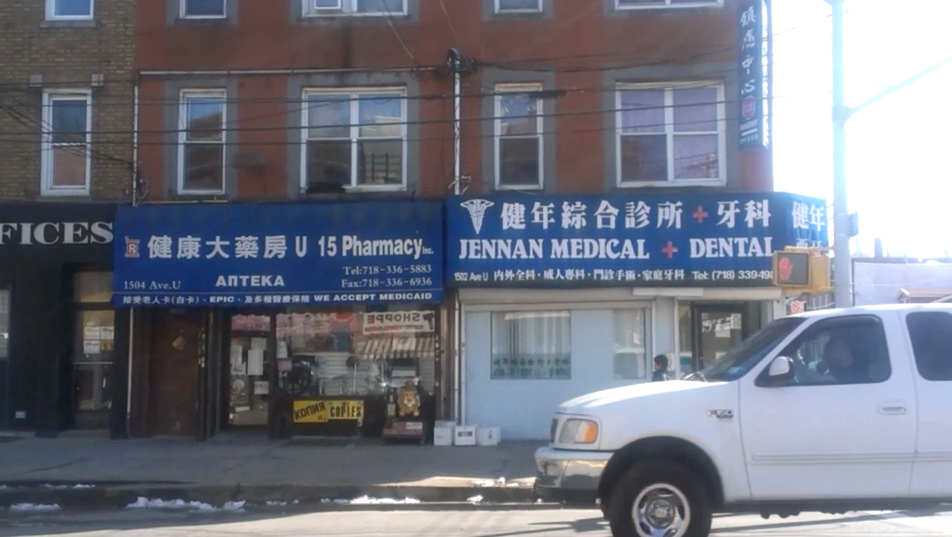
Below is an herb and acupuncture business. It appears to be Chinese owned and the employees there were also Chinese, but it had rather curious signs that advertised their services on their door. This store is an example of one of those places that made sure they wrote out what they offer in both Chinese characters and Russian.

Here is a close-up photograph of this Acupuncture business’ door. The entire orange paper on the left is written in Russian, telling about all the different services offered in this business and how beneficial these procedures are. The pink sign on the right is in Chinese and English (notice how English is the smallest writing comparing to the Russian and Chinese) and another orange sign in Russian advertising the health benefits of the massages offered. Again this all shows how the neighborhood is mostly composed of not only Chinese but also Russian-speaking people. 
Looking down a block of Avenue U, one sees mostly Chinese businesses with a few “English” ones in the mix, and then there are Russian pharmacies and stores. There were places like Lotus Bridal, Health Star Pharmacy Inc right across the street from Jennan Medical and Dental (both with as much Chinese writing on them as they had English), Paul’s Hair Salon Inc that showed a list of their services in Chinese only, etc. There were also Chinese bakeries and major supermarkets full of specialty Chinese foods and tea.
This store called International Food was more precisely a Russian food store, which becomes more obvious once one walks in or sees the other side of it not pictured here. It had big advertisements for Russian beer, and then inside there was food of various Russian brands. A girl that was behind the counter looked to be of Central Asian-Russian origin and she spoke Russian.
This International Food store was on Avenue Y, a couple residential blocks down from Avenue U. While walking down there, we also saw Muslim women. Also, there is most likely a sizable Jewish population, since a couple of blocks down from Avenue U we saw a Jewish Culture Center. So even though the neighborhood is dominated by two cultures, it is still quite diverse. 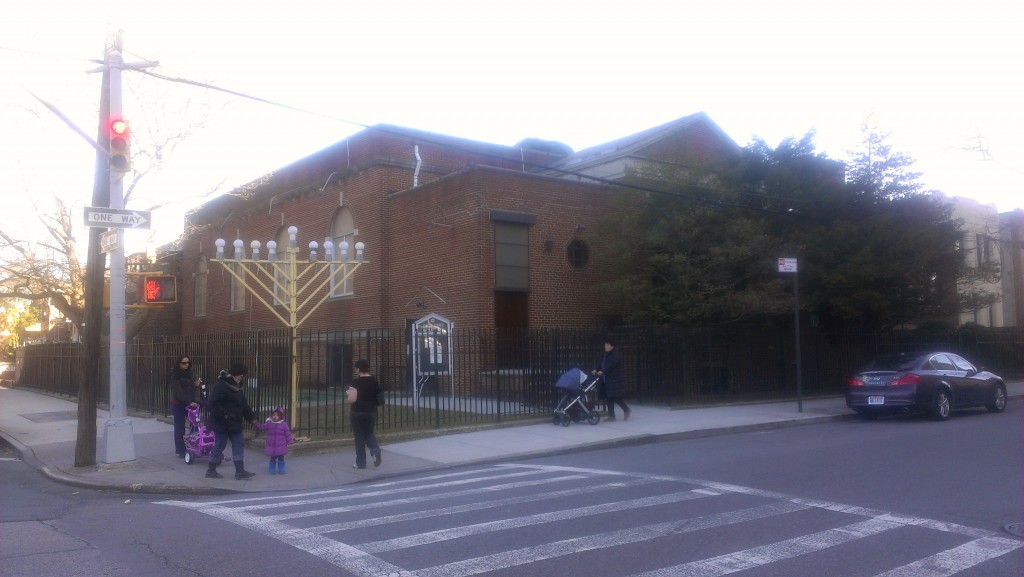
As for Hurricane Sandy interviews, we asked employees in stores if the business they work at was affected by the hurricane. We also tried to ask a couple of people if they live near this area and if their homes were affected, but frankly most people were startled enough when we initially simply approached them with our friendly “can we just ask you a couple questions”. I felt like because of our age (we were mostly noticeably younger than the people we were speaking to) and our strange questions about something that happened months ago it was really uncomfortable asking the people such personal questions. Asking about the business they are working at seemed more normal, but questions like “do you live around here” did not feel polite or acceptable. The atmosphere that we had, asking someone questions in a pharmacy with people waiting or in a busy bakery by the cash register, was not one that was fit for such a conversation. It was difficult to ask anyone about their home since it felt impolite and invasive at that point, especially if questions were related to whether there was “support between neighbors” and whether these people even speak to their neighbors.
Nevertheless, from the people that did agree to speak with us, we found out that:
- The U 15 pharmacy pictured above did not get flooded and only had power outage for one day, and the business quickly resumed to normal.
- The cashier lady at a bakery on Avenue U told us she lives two blocks south from the bakery and that her home had a power outage for one week and was it flooded. She said Avenue U was not flooded but buildings a couple blocks south from it (like her home) were.
- A man who works in a Russian business on Ave U said there were no power outages on Avenue U and that there was no flooding on the avenue whatsoever. He was quite surprised we had questions about Hurricane Sandy. He also said that it was Avenue Y and lower that had water damage and power outages.
- We asked a Russian pharmacist who worked in a Russian pharmacy on Avenue U about hurricane Sandy and she also said there was no damage on Avenue U and especially in their store. There was electrical outage either. We also asked her if this neighborhood is not only majority Chinese (as we previously thought it was) but also has a large Russian-speaking community. She said that it is true, the neighborhood is majority Chinese but the Russian-speaking community is also very prevalent.
- The lady who works at the International Food store that is located on Avenue Y (that so many others said was damaged by the hurricane) said that their basement was flooded but the store itself was mostly alright. It needed cleaning up after the basement flood before reopening again, but there was no power outage.
- Some people said they did not have time to speak to us and it was understandable because it was the middle of a busy workday. We encountered a language barrier with some other people and they did not seem to understand what we wanted to know.
Here are some examples of the things I mentioned: Chinese businesses, Chinese products in a large supermarket, Russian signs on businesses.
Manhattan Chinatown – Field Notes
12:45 pm, Uptown 6 Station – Lafayette and Canal Street:
The light, airy notes of the mandolin reach my ears as I exit the station. An older man plays with a peaceful look on his face, entranced by the music it emits. I, too, am entranced by the people rushing past me. I hear excerpts of their conversations – in both Chinese and English – and catch glimpses of their faces as they walk into the station. I notice a group of Chinese men and women pass through the turnstile. I pick up the fast pace of those around me as I emerge from the station. I am greeted with snippets of quick chatter, as the broad avenue lined with shops featuring shiny jewelry and multi-colored Pashmina scarves meets me. Amidst the hustle and bustle of pedestrians crossing the street, an old man comes up to me and asks, “Handbag? Louis Vuitton?”. The street signs for Canal, Mott, Baxter, and Mulberry are written in both Chinese and English, a manifestation of the culture rooted in this locale. The sign for McDonalds is written in Chinese as well, but I able to recognize it by the trademark arched yellow ‘M’. A man on the sidewalk is quickly making sweet mini cakes for the line of people in front of his cart. A pagoda-shaped directory catches my eye, and staring at the map, I am able to visualize the cultural importance of Manhattan Chinatown. The map points out particular streets, and what they are known for; it describes Mott and Canal Streets as the “heart of Chinatown”, and Grand and Mott as the perfect place when one is “shopping for fresh ingredients.” This world is teeming with life, business, culture, and dreams, and yet- I am amazed that this was precisely the area that was devastated by Superstorm Sandy a few months ago. This area was in the dark; it slipped through the attentions of government officials, thus cast aside in the face of an inevitable natural disaster. But not on this bright day.
Hurricane Sandy and Avenue U
Avenue U Chinatown while only 10 blocks long goes through both Homecrest and Sheepshead Bay. While Homecrest was not badly affected by Hurricane Sandy, Sheepshead Bay suffered critical damage. Sheepshead Bay really had as much damage as Staten Island and the Rockaways and yet relief took even longer to reach Sheepshead than the other two . Not only did Sheepshead Bay experience extreme damage, but it along with a large part of South Brooklyn was looted:
http://www.huffingtonpost.com/2012/10/31/hurricane-sandy-looting-brooklyn-coney-island_n_2047183.html#slide=1704488
Here is an account of a Sheepshead Bay resident when Sandy first hit:
“At 7:46, the water started coming in,” said Shannon White, 27, standing outside his destroyed house on Stanton Road. “At 8:10, I got out. The water was neck-deep.” He swam to safety with his dog on his shoulders — and then came back. “I got a canoe that washed up on Nostrand Avenue,” he said. “We were oarin’ with two pieces of wood like this,” he said, pointing to a broken fence. “We helped two old couples and a couple kids. I grew up here. This is all like family.”
http://nymag.com/daily/intelligencer/2012/11/sheepshead-bay-no-homes-no-power-no-relief.html
Here are some images of the damage in Sheepshead Bay area:



Finally here is a video of the aftermath of Sandy on Sheepshead Bay:
Emma Park-Hazel
Aftermath of Sandy: Chinatown
From asking people to doing research, I have learned that during Hurricane Sandy, the Manhattan branch of Chinatown was left completely in the dark.
This article explains the way the residents of Chinatown dealt with the black skies and black buildings. Businesses who had power or batteries and other necessities increased their prices greatly in order to stay in open.
This video shows a woman’s perspective of the aftermath of Sandy in Chinatown. People came to volunteer and help out Chinatown during this time of need, when businesses and houses were in the dark.
Wendy Li, Lisa Torre, Linda Wong – Chinatown Fieldnotes
We went to Chinatown in the evening to start exploring the neighborhood. We wandered around areas that we believed may have been affected by Hurricane Sandy. Here are some pictures of what we found.
- The Brooklyn Bridge was closed to traffic during the hurricane.
- One of many bakeries in Chinatown.
- The awning of the bakery looks like it needs repair.
- Construction in front of a plaza on Bayard Street.
- Elizabeth Center under construction.
- Restaurants in the tunnel between Elizabeth Street and Bowery Street close for night.
- Police Do Not Cross tape is caught on trees by the Brooklyn Bridge.
- The messy basement of a church.
- Souvenir shops that appeal to mainly tourists.
- A store for rent on Mulberry Street.
- Men continue to gather around games of chess even after it is dark out.
Manhattan’s Own: Chinatown
The working class neighborhood of Chinatown is home to many people of Chinese and Asian decent, as well as many other ethnicities. Since the Chinese began moving into this area around the 1800s, many changes have been seen in the neighborhood. For example beginning in 1999 the Chinese American community has celebrated the Chinese Lunar New Year. This event has attracted over 500,000 New Yorkers and tourists to Chinatown. This tradition celebrates the traditions and cultures of China, Korea and Japan.
Chinese immigrants throughout the United States began arriving in New York during the late 1870s, mainly due to the amount of anti-Chinese violence in the western part of the country. These newly arrived Chinese were forced to take low status jobs within the city. Entering with the opening of several Chinese grocery and specialty stores was a Chinese community. Unfortunately with the Chinese Exclusion Act of 1882, Chinese workers were not able to bring their families or wives into America, creating the “bachelor society,” made up of laboring men, leading to the rise of prostitution within this neighborhood. Finally during World War II the Chinese Exclusion Act and racial quota systems were abolished. An expansion of Chinatown, which in 1980 indicated the largest settlement of Chinese Americans within the United State, resulted from a increase in Chinese immigration. Nowadays Chinatown still represents the community of Chinese in New York City. Areas like Columbus Park offer a close feeling of community between the residents of this neighborhood, even on a cold day, one can find many people, both elderly and young relaxing, conversing and interacting whether playing table games or practicing Tai Chi.
http://www.nychinatown.org/history/1800s.html
http://www.explorechinatown.com/GUI/Content.aspx-Page=Discover&Type=History.htm
Munazza Alam, Nadera Rahman and Sara Camnasio
We explored Chinatown in a walking tour to see the local community.
Archival Research: Avenue U-Homecrest
Though this article and video are obviously fairly general in regards to emergency coverage in Brooklyn, the fact that Hurricane Sandy coverage was sub-par or lacking completely in southern Brooklyn (in comparison to Manhattan) is both disturbing and telling of the issues that could have affected Avenue U. Naturally, further research is crucial to establish a better picture of the problems specifically faced by the Sheepshead Bay, and consequently Homecrest area; however a most compelling line is: the “media should have been on the scene in these neighborhoods immediately after the storm…in order to convey the most important and useful information for victims and those looking to help.”
This short video from YouTube shows Avenue U conditions during Hurricane Sandy.
http://www.youtube.com/watch?v=X-mzNTRYtRI
While pictures of Coney Island devastation are many, specifically Avenue U damage is not as readily available; nevertheless the impact of the natural disaster is astounding:
http://www.brooklynvegan.com/archives/2012/10/coney_island_hu.html
(More to be added as needed.)
Archival Data for Homecrest, Brooklyn after Hurricane Sandy
Homecrest, Brooklyn wasn’t hit as hard by Hurricane Sandy as some of the areas around it. Homecrest’s border closest to the water coincided with where the flood waters stopped. As you traveled from this Avenue X border towards the Emmons Avenue Canal, which caused most of the flooding in the area, the waters got higher and higher.
The following video shows the water from the Emmons Avenue Canal beginning to rise. This footage was shot before Sandy hit land. The water continued to rise after this point.
http://www.youtube.com/watch?v=cWGNuXum4PI
Power outages in Homecrest were minimal, according to my friends who live in different parts of the neighborhood, and considering that no reports indicated otherwise. Power was lost for only several hours, and stop lights on the Ocean Parkway/Avenue U intersection were not working properly. The following is a post that appeared on a liveblog on www.brooklynpaper.com on October 30th, 2012, after Sandy had done most of its damage.
“5:26 pm: Traffic lights across Southern Brooklyn are on the fritz. Things are particularly dicey at the intersection of Ocean Parkway and Avenue U where stoplights not operating. Drivers heading across town should avoid Avenue U, and take Avenue T instead.
There are multiple trees down on Van Sicklen Street, at Gravesend Neck Road and between Avenues U and T.”
That pretty much covers how much damage Homecrest sustained.
No big looting incidents were reported in Homecrest. The biggest looting that was covered happened in Coney Island after Sandy, where people actually carried LCD televisions out of a Rent-A-Center in broad daylight, and thousands of dollars of liquor was stolen off shelves in late morning of October 30th, 2012.
http://www.nydailynews.com/new-york/brooklyn/looters-target-coney-island-sandy-article-1.1195080
Additional sources used:
http://www.brooklynpaper.com/stories/35/44/all_hurricanesandyliveblogday2_2012_11_02_bk.html
Impact of Sandy in Chinatown
Lower Manhattan, Chinatown being part of it, was one of the most hit parts of NYC by Hurricane Sandy in early Fall 2012. This neighborhood is still recovering from the effect of this disastrous storm, as some of its effects are still visible today. The media played an important role in giving an idea of the proportions of this disaster by portraying the during and the aftermath, also thanks to amateur photographers and filmers who documented what was happening.
Following a few resources about the effects of Sandy in Chinatown.
NY Times video about the effects of Sandy in Lower Manhattan: http://www.nytimes.com/video/2012/10/30/nyregion/100000001875311/lower-manhattan-after-the-storm.html
NY Times article about the impact of Sandy on downtown restaurants: http://www.nytimes.com/2012/11/07/dining/reviews/restaurant-review-after-hurricane-sandy-downtown-restaurants-need-patrons.html?_r=0
Wikipedia article on the effects of Hurricane Sandy: http://en.wikipedia.org/wiki/Effects_of_Hurricane_Sandy_in_New_York
Website on Chinatown in general: http://www.explorechinatown.com/
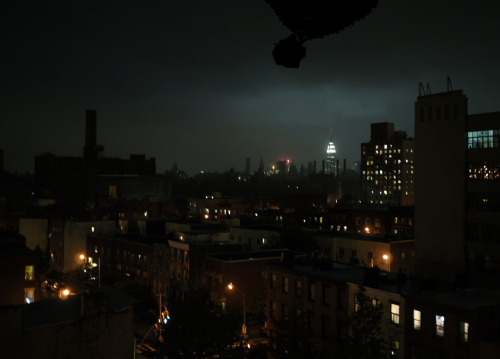
The black-out in Lower Manhattan caused by Sandy
Homecrest-Avenue U, a description
Homecrest is located in Brooklyn, NYC. The streets Kings Highway and Avenue X in the north and south bound the region, respectively; furthermore it is bounded by the streets Ocean Ave and Coney Island Avenue to the east and west, respectively. Avenue U is well within this region and is the site of increased Asian immigration and settling, it is well on its way to becoming a very prominent Chinatown. As of 2011, this Chinatown was roughly about 10 blocks in size, often compared to the size of Manhattan’s Chinatown in the early 1800s. The “newest” influxes of immigrants (1990s, 2000s) to this area are not only Chinese, however, as multiple Asian ethnicities seem to migrate to this location. Identification of where the Avenue U Chinatown from street-level is fairly easy; the preponderance of Chinese food markets, restaurants, nail salons, etc. is definitely evidence to the fact that Chinese live there. Having lived close by in the past, I can personally attest to the quality of the fish and produce there, haha.
Homecrest, Brooklyn
Homecrest Brooklyn is home to a population of 71,132 people. While Homecrest, Brooklyn has traditionally been populated by a large Italian community, it has experienced an influx of immigrants from Latin America, South Asia, Russia, and China. Avenue U has become New York City’s newest Chinatown. It runs through both Homecrest and Sheepshead Bay areas and is accessible by the B and Q train of the BMT Brighten Line. In fact, Avenue U is considered a second extension of Manhattan’s Chinatown because the Q train directly connects Canal Street, the main street in Manhattan’s Chinatown, to Avenue U.
The population of Homecrest is still mainly Caucasian, however the Asian population is slowly becoming more prominent in the neighborhood, followed by the Hispanic population. 46.9% of the population was born outside of the United States, showing how large of an immigrant population Homecrest really holds.
The average income of Homecrest is $46, 844 which is only slightly higher than Brooklyn’s median income. Homecrest also has significantly less percentage of people below the poverty line, 17.2% as opposed to in Brooklyn’s total percentage below the poverty line being 25.1%.
http://www.city-data.com/neighborhood/Homecrest-Brooklyn-NY.html
Emma Park-Hazel
Hurricane Sandy Aftermath: Homecrest
At least a part of the Homecrest area of Brooklyn was seriously affected by Hurricane Sandy, and one can see that is true just from looking at the Avenue U N train station photograph from the disaster: Source:http://www.dailymail.co.uk/news/article-2225164/Hurricane-Sandy-batters-New-York-Citys-subway-tunnels-flooded-network-shuts-down.html
Source:http://www.dailymail.co.uk/news/article-2225164/Hurricane-Sandy-batters-New-York-Citys-subway-tunnels-flooded-network-shuts-down.html


Source: http://prattcenter.net/map/toward-informed-rebuilding-documenting-sandys-impacts
According to this map, the main Homecrest area was not flooded by Hurricane Sandy, but water came up really close to it. Maybe the map labeling of neighborhoods is not entirely accurate since Avenue U passes through the center of Homecrest and it was obviously flooded at least partially, according to photographic evidence like the train station picture above.
Since there is not much information regarding flooding of the Homecrest neighborhood, overall the conditions were probably not as bad as in some other, more coastal places.
Some primary sources reported power outages. (More information to follow.)
Homecrest, Brooklyn, NY
Below is a map of Homecrest, Brooklyn, NY taken from www.city-data.com which clearly defines the borders of the neighborhood. According to the map, Homecrest spans from Coney Island Avenue to Gerritsen Avenue and from Kings Highway to Avenue X, for a total area of about 2.2 miles. The population of Homecrest, Brooklyn at the time of writing of the article on www.weichert.com was just over 71,000 people, with the median age being 40.96 years (see bar graph below). The data represented on this map shows what percent of the population in different parts of Homecrest is Asian. These percentages range from 1% to 54% with the most Asian people living on, or very close to, Avenue U. These percentages are rather low when compared to Manhattan’s Chinatown, where the percent of Asians is approximately 95%, on average, with small portions of the neighborhood falling just below 80% Asian. Although this comparison may lead one to claim that Homecrest should not be considered a Chinatown, one must keep in mind that Homecrest’s area is over twenty times that of Manhattan’s Chinatown (2.189 square miles vs. 0.108 square miles). Additionally, Chinatown’s population density is 82, 417 people per square mile, while Homecrest’s is 32,488 per square mile, so the percentages of Asians in each area are very misleading (www.city-data.com).
I live not too far from the section of Avenue U that is within Homecrest, and, over the years, I have witnessed the evolution of the neighborhood into a Chinatown. Over the past decade the number of Asian grocery stores and restaurant on Avenue U has grown significantly. Homecrest has become Brooklyn’s second largest Chinatown and considering the fact that it was born less than two decades ago, we can safely conclude that it has much more potential for development. This large land area, when compared to that of Manhattan’s Chinatown, and the continuing migration of Chinese residents of New York City, especially from other parts of Brooklyn, into the neighborhood, will certainly allow for this Chinatown to become as established as the Chinatown which we call Chinatown.
http://www.weichert.com/search/community/neighborhood.aspx?hood=5689
http://www.city-data.com/neighborhood/Homecrest-Brooklyn-NY.html
Archival Research-Chinatown
Here are a few videos about the effects of Sandy on Chinatown:
Chinatown while recovering from Sandy, gets ready for Election Day: http://vimeo.com/52902492
This video includes segments that show how there was little help in clearing fallen trees in Chinatown. It also shows how some businesses were affected by the storm and power outages.
One Dolla, Chinatown by Jane Teeling:
http://vimeo.com/52664895
This video shows a one-dollar store that opened up after the hurricane. It shows how not everyone took advantage of the situation to raise prices and to make money off the devastation.
Here are sites that show the aftermath of Hurricane Sandy on Chinatown:
http://www.ourchinatown.org/2012/11/29/post-sandy-chinatown-updates-and-links/
This is a collection of posts from the Asian American Writer’s Workshop’s Open City Magazine, which covered the effect of the storm from day one.
http://voicesofny.org/2012/11/chinatown-business-owners-blast-government-over-lack-of-support/
This article assesses the damage the hurricane inflicted on the businesses in Chinatown and whether or not the customers will return.
This is a compelling image of the blackout that occurred in lower Manhattan as a result of the storm.
(http://www.chinatownpartnership.org/newsletter/2012%2011%2007%20Hurricane%20Sandy%20-%20Chinatown%20Update.htm)
The Day After in Lower Brooklyn/ Coney Island
Looting became a problem in the following days and many threatened shop owners created signs warning off potential thieves.
— This video was taken by a resident and not professionally edited but it tours right through the center of Coney Island and shows the situation just hours after the storm.
–The first video includes interviews of local residents and was done by the New York Post.
Homecrest Information
Homecrest, Brooklyn is home to about 71,000 people, and 17,000 households. The majority of these people are in their mid 40s to mid 50s, with an average income of $47,453. However, it is not a bell curve, because the majority of households only earn 0K-10K a year, and the next majority earns 75K-100K, as shown by this graph.
Their hospitals include Homecrest Health Center, Coney Island Hospital, NY Presbyterian Community, and Beth Israel King Highway.
Homecrest is New York City’s newest Chinatown and came into creation around 2000. It is in a way directly connected to Manhattan’s Chinatown since both are close to the Q trains. Homecrest/Avenue U came about because of the overpopulating of Sunset Park, as dictated in the NYC/LA Zhou, Chin, and Kim article.
http://www.weichert.com/search/community/neighborhood.aspx?hood=5689
http://combosaurus.com/interest/homecrest-brooklyn
U大道
The Homecrest neighborhood is considered to be the second Brooklyn Chinatown, with the first one located in Sunset Park. Avenue U is the main street of the Homecrest Chinatown area, probably because it is a large commercial area and it runs through in the center of Homecrest. This area of Brooklyn began expanding as a Chinatown approximately in the early 1990s and is still expanding today.
This map shows the boundaries of Homecrest and the color coding represents the percent of foreign-born residents of this area. Some of these sections (yellow) show as much as 69% foreign-born residents.

Here is the same map (with a slightly different zoom) that shows the percentage of the Chinese population in this area according to the 2010 US Census.
The boundaries of this neighborhood are Coney Island Ave on the left side, Knapp Street on the right side (both shown in in this map), Kings Highway on top and Avenue X on the bottom (almost identical to top and bottom boundaries of this map). The darker the red color, the higher the percentage of Chinese people living in that area. The darkest red shows 90% to 99% and the slightly lighter shade 75% to 90%. The bright orange represents 60% to 75%.
D and Q trains connect this area to the Manhattan Chinatown. The population of Homecrest is 71,096 people. It is more at risk for hurricanes than the US average, but not by much. The natural force this neighborhood is most at risk for is wind, with its risk higher than national average by 135%.
The median age for people in this neighborhood overall is early 40s, while the median age for Asian people is slightly younger than that: most would be in their late 30s. Most households in this area, usually 65% and higher, are households without children. Households with children are approximately 1/3 of the households here.
Sources:
http://www.weichert.com/search/community/neighborhood.aspx?hood=5689
http://www.city-data.com/neighborhood/Homecrest-Brooklyn-NY.html
http://www.nytimes.com/1995/10/22/nyregion/neighborhood-report-sheepshead-bay-new-language-and-a-new-life-for-avenue-u.html
socialexplorer.com
Chinatown Description
Chinatown in New York City is the largest Chinese enclave in the United States. It began with a few migrants from China and grew as the workers that were displaced after the completion of the transcontinental railroad moved east to avoid antagonism from white laborers. In New York City, the majority of the Chinese population was men. The ratio of men to women was so large that prostitution was rampant. Gangs developed to run these brothels. They also provided the city with services, such as sanitation, which the city neglected to provide the area. Although the Chinese were faced with hardship, they brought their unique culture to the city. They main unit of their community was the shop. There they gathered to talk about news from China as well as to receive and to send letters back home to their families.
Today Chinatown is still a very busy community that exhibits a rich and diverse Chinese culture. As a major tourist attraction, there are stores specifically geared towards non-Asian customers, in addition to stores that are mainly visited by residents. Chinatown is also sometimes known for the smells coming from the fish markets and the garbage on the streets. This, however, is only a small part of Chinatown. Open stores and stands can be seen selling vegetables and there are bakeries nearly on every street. There is a Chinese School on Mott Street and several public schools throughout the community. Restaurants with food from different provinces can also be found, offering a wide range of cuisine options for any visitor to Chinatown.
In addition to a diversity of places to visit, there is a diversity of people living in Chinatown. The majority of the people living in Chinatown, however, are working age adults. Yet, with this statistic, one third of the people living in Chinatown live below the poverty line. This shows that although Chinatown is one of the largest Chinese communities in the New York City, it is also where a large number of impoverished Chinese live.
http://www.ny.com/articles/chinatown.html
http://www.aafny.org/cic/briefs/Chinatownbrief.pdf
-Wendy Li
Chinatown
Chinatown is never stagnant, and always changing, much like the rest of New York City. As different ethnic groups come and go, they leave a part of themselves behind. Just like how the Italians left their Italian culture in the form of food, the Chinese have left their culture as well. After the Exclusion Act was lifted in 1943 and a quota was given to China, the immigrant population in Chinatown began to increase. After the quita was abolished in 1968, the immigrant population shot up. As a result, Chinatown expanded and even today, Chinatown is still expanding.
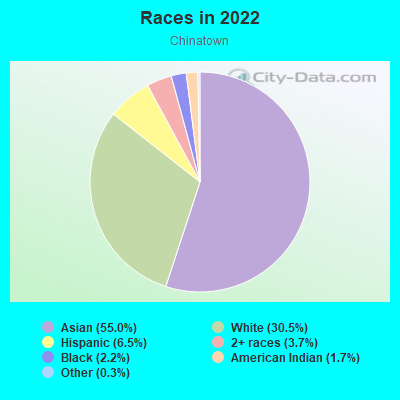
In today’s Chinatown, majority of the population is still Asian. However, there are still other races evident living in Chinatown. As seen in the picture, majority is still Asians who live alone compared to the other races. The percentage of single-mother households among all households in Chinatown is 3.0%, whereas New York is 12.5%. There is a rather large difference of around 9.5%, which is interesting. The percentage of people who speak English not well or not at all is 51.2% in Chinatown, and 12.2% in New York. That is not as surprising, since Chinatown is a place where immigrants gather. Most of the people who live in Chinatown work in Chinatown, since Chinatown is home to so many restaurants and businesses. Most of the residents walk as their mode of transportation. In respect with education, the percentage of students in K-12 schools is 14.5% in Chinatown and 19.4% in New York. The percentage of students enrolled in private schools is 6.7% in Chinatown and 18.8% in New York. The percentage of the population below the poverty line in Chinatown is 31.2% and 21.2% in New York.
http://www.city-data.com/neighborhood/Chinatown-New-York-NY.html
Chinatown Archival
The following is a personal account of what happened on Hester Street Day 4 after Hurricane Sandy hit. Lines were forming for food and necessities while community organizations were handing them out for two days before FEMA showed up to offer aid.
http://opencitymag.com/after-hurricane-sandy-day-4-hester-street-in-lower-manhattan/#.UJRgEGl25-I
This link shows a personal account of a Sukjong Hong, who went into a building to help those in need of getting necessities after the hurricane. There are drawn pictures documenting what happened instead of real pictures.
http://opencitymag.com/left-in-the-dark/
The following are pictures of the volunteers and the effort to help the people in Chinatown, who were left without electricity.
http://opencitymag.com/hurricane-sandy-day-4-lower-east-side-and-chinatown/
The following newsletter contains information about subway lines, important information about food (whether it is safe to drink or not), contact information, financial assistance, school information and so on.
Archival Research: Sandy Impact on Chinatown
The following are links (including news articles and blog posts) recounting the conditions of Chinatown after Hurricane Sandy:
Who Stayed Open When Sandy Shut Down Lower Manhattan? — http://newsfeed.time.com/2012/10/29/southside-sandy/
Hurricane Sandy: Chinatown Black Market Emerges as Vendors Hawk Batteries, Candles, Outlets —http://www.huffingtonpost.com/2012/10/31/hurricane-sandy-chinatown-black-market_n_2050754.html#slide=1708150
Chinatown Post-Sandy by Ellen Jovin — http://ellenjovin.com/blog/entry/chinatown_post_sandy
This article form “The Epoch Times” provides telltale photographs with detailed captions of the aftermath of Hurricane Sandy on various areas, a wine and liquor store near Chinatown being one of many — http://www.theepochtimes.com/n2/united-states/hurricane-sandy-live-updates-new-york-city-308115.html
The following article traces and discusses the impact of Hurricane Sandy on the lives of immigrant workers in Chinatown — http://opencitymag.com/hurricane-sandy-impact-on-immigrant-workers/
Though this is unrelated to the lives of humans that were affected in Chinatown, during my research, I came across this article and thought it was a very interesting inquiry to raise in regard to the environmental effects of Hurricane Sandy. The article discusses the impact that the storm had on New York City’s rat population in different areas, one of which was Chinatown — http://nj1015.com/what-impact-did-sandy-have-on-nycs-rat-population/
The following videos show authentic footage of the aftermath of Sandy in Chinatown:
“Hurricane Sandy Aftermath; Chinatown; November 2, 2012” – https://www.youtube.com/watch?v=lO5nm1I4XIY
“Weathering Superstorm Sandy in Chinatown” – https://www.youtube.com/watch?v=5msfFKRKD7I
Archival Research
Article/Video: Chinatown Business Grants Try To Get Neighborhood Past Sandy Slump http://manhattan.ny1.com/content/top_stories/177049/chinatown-business-grants-try-to-get-neighborhood-past-sandy-slump
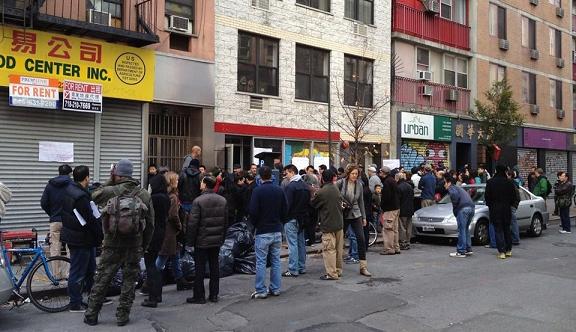
Line outside of one of the CAAAV, a organization that assists and offers help to Asian Americans, office.
VIdeo: Weathering Super Storm Sandy in Chinatown: People coming to the aid of Chinese Americans in Chinatown and detailing how the demographics played a role in the timing of aid.

The CAAAV organization handing out non perishable items following Hurricane Sandy.
Video: Chinatown relatively deserted following Hurricane Sandy
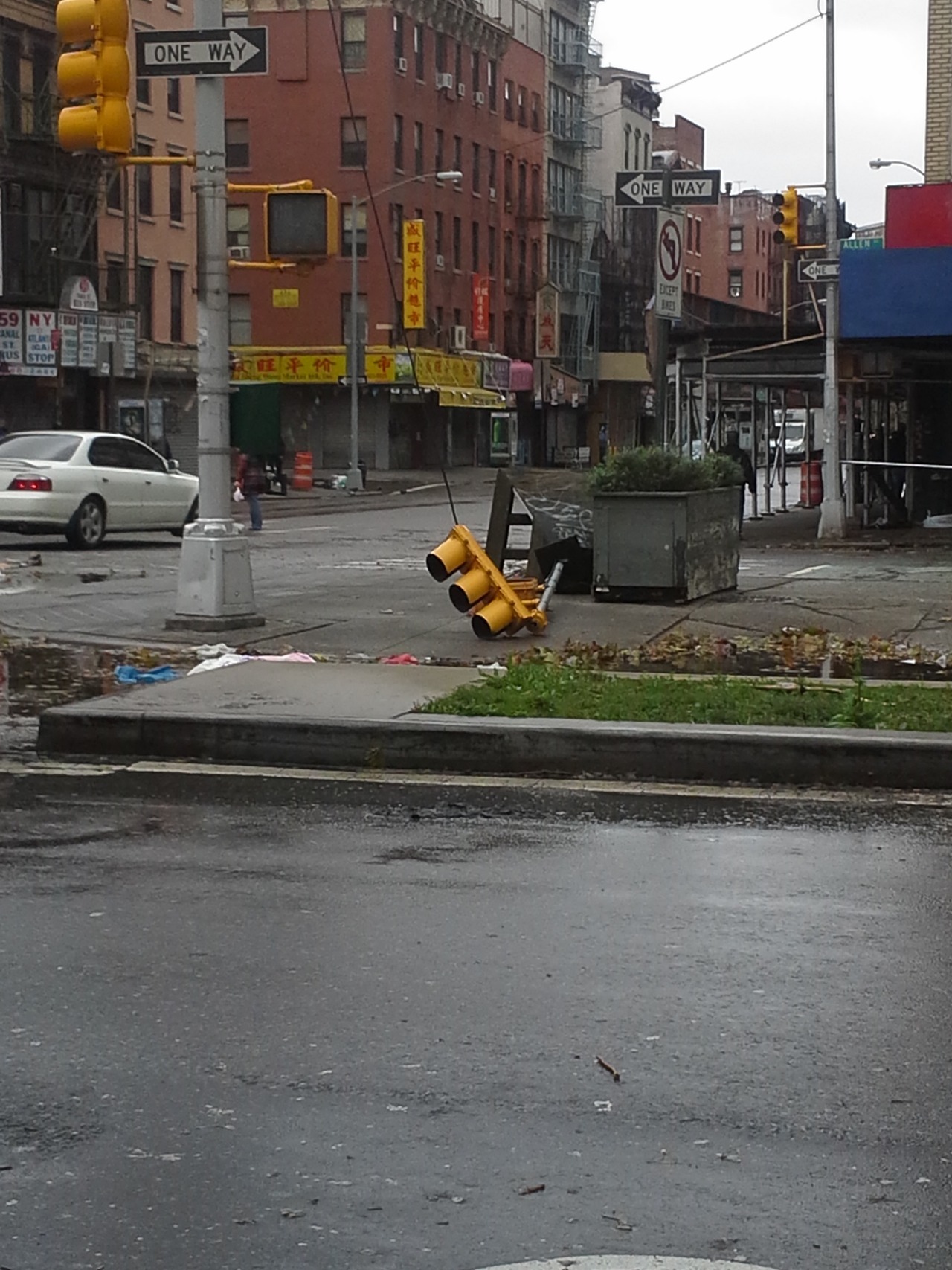
Photo documenting the damage from the corner of Allen Street and Canal Street following Hurricane Sandy.
Demographics of Chinatown regarding median Household Income, single males, single females, median age, homes with kids and average household size in relation with New York and on a national level.
http://www.zillow.com/local-info/NY-New-York/Chinatown-people/r_193821/

Wooden debris on Pike Street, Chinatown.

A business left in the dark following Hurricane Sandy.

Chinatown residents wait in line for National Guard aid distribution in front of Confucius Plaza. (Photo by: Chinatown BID / CPLDC)

Chinatown BID assists with aid distribution in Chinatown. (Photo by: Chinatown BID)
Article regarding the state of businesses following Hurricane Sandy: http://www.nytimes.com/2012/11/07/dining/reviews/restaurant-review-after-hurricane-sandy-downtown-restaurants-need-patrons.html?_r=0&pagewanted=print
Chinatown Description
Chinatown is the mecca and heart of Chinese culture. It is the home of the first major Chinese enclave in the US. Despite initial acts of discrimination such as the Chinese Exclusion Act, the Chinese were able to grow and form a strong community. Filled with boutiques full of fashion, souvenir shops, general stores, karaoke lounges and, of course, a plethora of food eateries to satisfy one’s hunger, just about any and everything is available. Yet, such is just a snippet of what Chinatown has to offer.
As both a residential and commercial community, a tourist gets the best of both worlds. Walking up and down anywhere between Broome Street to the North, Allen Street to the East, Worth Street to the South and Lafayette Street to the West, one could get a sense of how the Chinese live, relax and play. If you walk pass Columbus Park you are sure to find the elders engaged in an intense game of chess. For the more “Americanized” Chinese youth you are sure to find them engaged in a game of handball at the Grand St. Park.
And last, but certainly not least, if you are a food avid, shall I just say, if you want to go to your early heaven, look no further than Chinatown. It has the delectable, authentic cuisine of China, minus the long plane ride. Not only is the food delicious but the possibilities unlimited. If you want to make a conservative choice one can simply go with the popular dumplings and bubble tea, might I say, two personal favorites of yours truly. If you want a traditional Chinese meal I would suggest you try a dim sum, a variety.
Then if food is not you thing, although I find such hard to believe, one could simply go to Chinatown to take in its marvelous history. There is Confucius Plaza, the Church of Transfiguration and Five Points just to name a few. Easily accessible from Brooklyn, Queens and Manhattan’s east and west side via the 6, Z, D, B, N, Q, R, J, and M, there is no reason not to go and experience something new, different and historical.
Archival Research – Chinatown and Hurricane Sandy
This is a site with many pictures of Chinatown in general:
http://www.nychinatown.org/manhattan.html
Video tour of Chinatown:
Article about some of the aftermath of Sandy and the recovery (with images):
http://www.huffingtonpost.com/2012/10/31/hurricane-sandy-chinatown-black-market_n_2050754.html
Info on recovery and volunteering after Sandy in Chinatown:
http://www.ourchinatown.org/2012/11/06/hurricane-sandy-volunteering-and-donations-update/
Videos on the aftermath of Sandy in Chinatown and the Lower East Side:
Chinatown Description
Chinatown, Manhattan, is located near the Lower East Side. There are about 90,000 to 100,000 people here. Chinatown encompasses the largest population of ethnic Chinese people outside of Asia. Residents come from various different parts of China, and they speak different languages (mainly Mandarin, Min, and Cantonese). Chinatown’s borders are considered Broome Street, Allen Street, Worth Street, and Lafayette Street. Some of the main things people should see when visiting Chinatown are the Museum of Chinese in America, Columbus Park, Sara Delano Roosevelt Park, and Chatham Square.
After the Immigration and Nationality Act of 1965 many more Chinese immigrants were allowed into the country and Chinatown’s population greatly increased. After September 11, 2001, Chinatown suffered because tourism and business slowed for a few years; however, it has increased again. Higher luxury apartments being built in the area also contribute to this boost. Chinatown is filled with many businesses as well, including fish markets, jewelry stores, and green grocers.
Manhattan Chinatown Description
Manhattan’s Lower East Side is home to Chinatown, a rich cultural enclave steeped in Chinese-American history. Canal Street, Pell Street, Mott Street, and Mulberry Street are commonly known areas in this urban niche. The signs for some of these streets are written in both Chinese and English, thus testifying to the dominant presence of Chinese culture in the area. This downtown enclave is home to landmarks such as Confucius Plaza, the Museum of Chinese in America, the Church of the Transfiguration, Columbus Park, and the Bloody Angle. In the past, the latter two have been sensationalized to focus the public’s attention to Chinatown in the press. More than half of Chinatown’s population, approximately 59%, is foreign born. Among this large number of immigrants, who bring to New York their rich culture along with their hopes and dreams, about 57% of residents have Limited English Proficiency. In the year after 9/11, the Chinatown garment industry lost about $490 million. The median household income for Chinatown residents ranges from $27,227.00 +/- $7,802.00. As a standard for comparison, the middle class income statewide is between $50,282.00 to $63,315.00. Further, the median monthly rent for residents is $854.00 +/- $114.00, whereas the statewide middle rental range is approximately $812.00 to $1,013.00. According to the 2010 Census, the population of Manhattan Chinatown dropped about 8.7% in the past ten years. This population decrease might be due to the pattern of outmigration among the Chinese from traditional Chinatowns to suburban areas. This influx of people in and out of Chinatown is another characteristic that draws attention to its dynamic nature. The term ethnic enclave can be thus applied to Chinatown, drawing attention to the fact that it is a concentrated center of rich Chinese culture and Chinese-American history.
http://www.richblockspoorblocks.com/
http://www.aafny.org/cic/briefs/Chinatownbrief.pdf
http://fi2w.org/2011/05/04/with-a-shrinking-immigrant-population-manhattans-chinatown-ponders-future/
For lots of photos (organized by street) and links to newspaper articles specifically about Manhattan Chinatown: http://www.nychinatown.org/manhattan.html
中国城
The Chinatown in Manhattan is the largest Chinatown in the United States. It is als home to the largest concentration of Chinese in the western hemisphere, with a population that is estimated to be between 70 and 150 thousand. However, the Chinese are not the only immigrants that live there, and over the years others have moved in and out of the area. Chinatown’s history is rooted in Chinese traders and sailors who came to America, however the biggest rush of Chinese came after the completion of the Central Pacific Railroad and the Gold Rush. Much of Chinatown’s history also connects to the Chinese Exclusion Act (1882-1943) which attempted to keep as many Chinese out of the US as possible by not allowing women and only allowing the sons of those already here to come across. And although Angel Island is on the other side of the country, it also had its effects on who made it to Manhattan’s Chinatown. Chinatown was originally almost all tenement apartments; in modern times many families still live in close proximity, but the conditions are somewhat better (especially when the older generations die and leave the apartments to the hands of the owners). Chinatown is considered a tourist attraction, however its also an area that is called home to thousands and thus the same things that are important to those living further uptown are important to those living in Chinatown. (http://www.ny.com/articles/chinatown.html)
The 6 headings for newspaper articles on http://www.nychinatown.org are Gentrification, Neighborhood Issues, Civil Rights, Lifestyle, Crime & Punishment, and Historical. These headings show us only a bare minimum of issues that are important to people who live in Chinatown, they are also issues that should be important to those who live in other parts of New York City and the rest of the world.
The streets that are encompassed in Manhattan’s Chinatown are Allen Street, Baxter Street, Bayard Street, The Bowery, Broome Street, Canal Street, Catherine Street, Centre Street, Centre Market Pl, Elizabeth Street, Market Street, Chatham Square, Essex Street, Chrystie Street, Grand Street, Mosco Street, Division Street, Henry Street, Mott Street, Doyers Street, Hester Street, Mulberry Street, East Broadway, Kenmare Street, Orchard Street, Eldridge Street, Madison Street, Park Row, and Pell Street.
The following is a map from http://www.nychinatown.org, however another good map can be found at http://www.explorechinatown.com/PDF/explorechinatownmap.pdf

Manhattan’s Chinatown is rich in culture and its streets hold many museums and arts/cultural centres. These include the Asian American Arts Alliance, the Asian American Arts Centre, the Chinese Music Ensemble of New York, the Chen Dance Center, the Museum of Chinese in America (which we are all familiar with), the New York Chinese Cultural Center, and many more. http://www.explorechinatown.com/ is a good site to visit to learn more about how you can get the most out of your visit to Chinatown, as well as keeping those who visit the site up to date on the latest news in Chinatown.
Manhattan Chinatown – Archival (2)
The links below are daily updates on the post-Sandy situation. Perhaps we can use the details included in these entries to focus our questions for interviews. The entries also have lots of photos!
http://caaav.org/update-on-caaavs-efforts-post-hurricane-sandy-volunteer-and-donate
http://caaav.org/day-2-hurricane-sandy-relief-efforts-from-caaav
http://caaav.org/day-3-500-volunteers-and-the-lights-are-on
http://caaav.org/day-4-re-allocating-resources-to-far-rockaway-red-hook-and-staten-island
http://caaav.org/november-4th-hurricane-sandy-update
Coney Island Description
The neighborhoods that are often considered part of Coney Island include Sea Gate, Coney Island Proper, Brighton Beach, and Manhattan Beach. Coney Islands identity is rooted in its history as a resort. Its beaches, amusement parks, and restaurants are well-known throughout the city. Following WWII, the park faced a decline as the infrastructure of the area was neglected. Though still a prominent tourist destination, the area is in need of significant capital investment. This need was only amplified by Hurricane Sandy, which wrought destruction on the area’s famous boardwalk and amusement park.
This website is similar to social explorer but it lacks the fancy graphics. It provides a coherent breakdown of Coney Island’s area code in terms of finances, marital status, ethnicity etc. The website is actually intended for real estate to give potential buyers an idea of the neighborhood they are considering moving into, but the information serves our purposes well.
Some quick stats:
-Median age is 43
Ethnicity: Majority White but also large Asian, Hispanic, and Black populations.
-Total Population (including Sheepshead Bay) : roughly 286,000
-Most common educational level is a bachelors degree
-Median household income of $52,000 (according to this website but varying on others).
_In a significant number of crime rates Coney Island is above the “national average”.
http://homes.point2.com/Neighborhood/US/New-York/New-York-City/Brooklyn/Coney-Island-Demographics.aspx
-Victor Rerick
Chinatown Hurricane Sandy
These are some pictures of the aftermath of Hurricane Sandy in Chinatown.
Here are some videos about the aftermath of Hurricane Sandy on Chinatown. Many stores were closed, electricity was shut down, and city officials were not attending to Chinatown’s needs.
Chinatown
One does not have to travel to China to experience the Chinese culture; instead he/she can take the subway to Chinatown. Located in Manhattan, nestled between Little Italy and the Lower East Side, Chinatown is the home to one of the largest enclaves of Chinese people in the Western Hemisphere. This area is filled with authentic Chinese restaurants, boutiques and souvenir shops.
Since the 1800s, Chinatown has been a home to many immigrants. After the Chinese Exclusion Act was lifted, many Chinese Americans flocked to this area to form their own community, attempting to escape racial discrimination. Although this area is a favored destination for Chinese immigrants, it is also home to different ethnic groups such as Dominicans, Filipinos, Puerto Ricans and Vietnamese. The population of Chinatown is estimated to be over 100,000 people.
There are many sites that one should visit while in Chinatown. These are the Museum of Chinese in America, Columbus Park, Confucius Plaza, the Original Chinatown Ice Cream Factory, and Chatham Square. Chinatown is accessible by the public transit system through the 4, 6, N, Q, J, Z, and R trains.
Source: http://www.ny.com/articles/chinatown.html
Manhattan Chinatown – Archival
1) http://caaav.org/caaav-endorses-joint-statement-on-federal-grants-for-sandy-relief
CAAAV works towards organizing Asian communities, particularly immigrants and low income families. CAAAV seems to be active in enabling others, and its site hosts extensive Sandy documentation. This article draws attention to the ongoing Sandy relief efforts of the CAAAV. It reiterates the relevance of the storm even today, further validating the credibility of our project.
This excerpt focuses on the $45,000 collected for the Chinatown Sandy Fund. It is interesting to note that such relief efforts are given so much attention, considering the fact that city officials were seemingly absent in Chinatown during the actual disaster (as elucidated in the CAAAV video posted earlier.)
3) http://live.nydailynews.com/Event/Tracking_Hurricane_Sandy_2?Page=2
A new side of the story to perhaps include – Chinatown was also home to Hurricane Sandy shelters. Reaching out to volunteers could provide us with a neutral perspective on the situation and orient our project (understand how people came into shelters, what they did during their time there, and how they left these shelters).

Seward Park High School in Chinatown served as a shelter for the Hurricane Sandy.
(Mariela Lombard/for New York Daily News)
These are excellent co-references to the testimonies given in the CAAAV video that Lindsay posted. The article acknowledges the power outages in Chinatown and other parts of the Lower East Side, and even cites includes Confucius Plaza (the last site we visited on our tour!) as one of the places experiencing water and power problems. The Con Edison Power Outage Map provides a nice visual of the power outages during Sandy, and shows that Chinatown (center) was hard hit. Maybe we could do a nice ‘Ken Burns’ of this map!

Con Edison – Hurricane Sandy Power Outage Map

